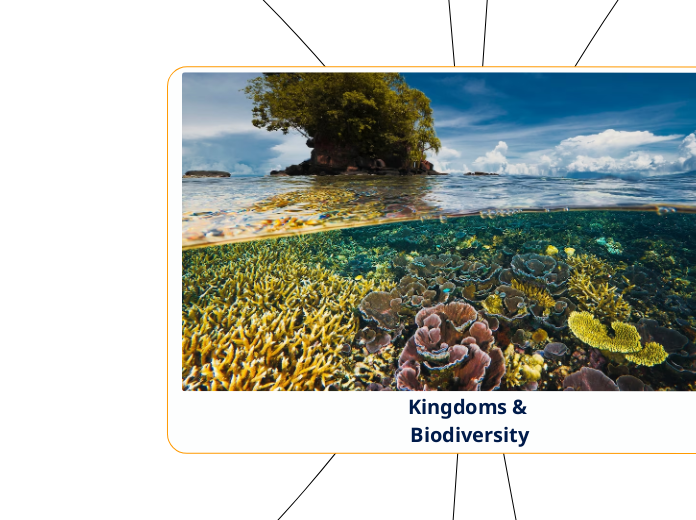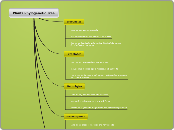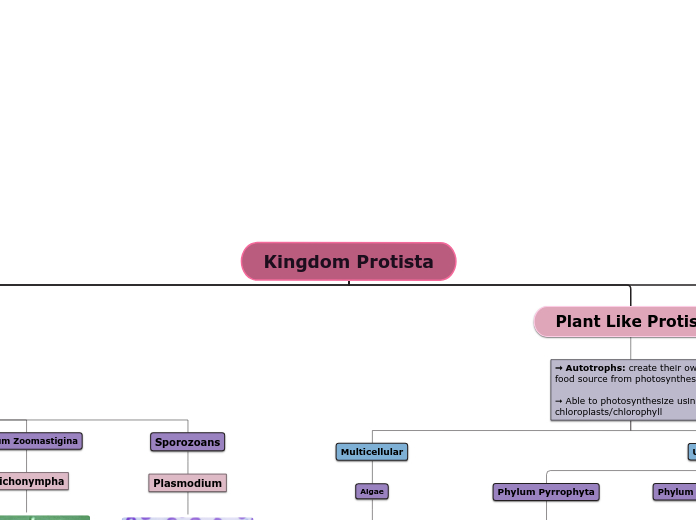Kingdoms & Biodiversity
Viruses
Since viruses cannot be killed by antibiotics (since they are not bacteria), vaccines are used instead to train the body with a weaker version of the virus to provide immunity against it later on.
Methods of contracting viruses:
Skin contact
Bodily fluids (coughing/sneezing)
Insect/animal bites
Saliva
Three methods of classifying viruses:
By reproduction method
Lysogenic cycle: infects the host cell and embeds its DNA into the chromosomes, where it remains dormant for later activation into the lytic cycle.
Lytic cycle: infects the host cell with instructions to reproduce more of the virus.
By genetic material: DNA or RNA
RNA example: coronaviruses
Retroviruses are able to embed their RNA into the host cells DNA to modify the genetic material.
DNA example: chickenpox
By shape of capsid
Complex: icosahedral & helical
Helical
Icosahedral
Structured out of three main parts.
Envelope
Capsid
Nucleic acid
Exponentially smaller than cells and bacteria; measured in nanometers (a billionth of a meter).
Considered an infectious material made up of protein and genetic material.
Not considered as living things.
Reason 3: Does not react to stimuli or produce cellular respiration.
Reason 2: Has no cell structures or features such as membranes or cytoplasm.
Reason 1: Cannot reproduce on their own; need hosts to deliver reproduction instructions.
Eubacteria
Able to be classified by a gram stein test using a dye made of crystal violet and iodine.
Bacteria that have a thin layer of protein and a layer of peptidoglycan that is sandwiched between two layers of plasma membrane will have cells that appear light pink during the test.
Bacteria that have a thick layer of protein and thick outer layer of peptidoglycan will have cells that appear purple during the test.
Generally are mesophiles and live common/moderate conditions.
Able to utilize the photosynthesis process and produce oxygen as a byproduct. Example is cyanobacteria.
Constructed with a cell wall, cell membrane, flagella, ribosomes, and DNA; all of which is shared with archaebacteria.
Derived from the Bacteria domain.
Known as "true bacteria", as this is the category people commonly refer to when they think of bacteria.
Archaebacteria
Speculated after the discovery of the Asgard group of archaebacteria that eukaryotes (like us) are actually descendants of the Archaea domain.
Able to asexually (on their own) and sexually (with a partner) reproduce.
Sexual method: One cell connects a pilus tube to the other cell to transfer chromosome information.
Asexual method: binary fission through fragmentation and septum formation to separate cells. Budding and fragmentation methods are also available.
Generally are extremophiles and live in harsh/remote conditions.
The ability to withstand many extreme living conditions makes them useful in biotech applications such as PCR (polymerase chain reaction).
Example 3: Halophiles living in areas of extreme salt concentration.
Example 2: Acidophiles living in areas of pH levels as low as 0.
Example 1: Thermophiles living in areas of extremely high or low temperatures
Can be autotrophs and heterotrophs (either producing their own food or extracting it from another source).
Able to produce methane while lacking oxygen (anaerobic) in a process called methanogenesis.
Include features that make them unique from eubacteria.
Ribosomes are more related to eukaryotes than bacteria.
Fatty acids are linked with ether bonds rather than ester bonds.
Cell wall is not made of peptidoglycan.
Constructed with a cell wall, cell membrane, flagella, ribosomes, and DNA; all of which is shared with eubacteria.
Formerly classified with eubacteria as a single kingdom called Monera.
Derived from the Archaea domain.
Known as "ancient bacteria", as they were discovered to be found in remote and prehistoric locations.
Protista
Grouped based on their nutrition:
Group 3: Plant-like protists
Euglenozoa
Euglenoids have an eyespot to see light and switch between being an autotroph and heterotroph in the sunlight and dark respectively.
Pyrrophyta
Dinoflagellates have two flagella and are able to produce bioluminescent light.
Chrysophyta
Diatoms are the phytoplankton that have rigid walls and are an important food source for marine organisms.
Group 2: Fungi-like protists
Oomycota
Water molds that are filamentous and sometimes parasitic.
Acrasiomycota
Cellular slime molds have one nucleus each and ingest bacteria and yeast.
Myxomycota
Plasmodial slime molds are slime-like and contain multiple nuclei.
Group 1: Animal-like protists
Sporozoans
Parasitic; version called plasmodium causes malaria.
Zoomastigina
Flagellates have flagella, allowing them to move.
Ciliophora
Ciliates have hair-like cilia, allowing them to move through water and transfer food into its gullet.
Cercozoa
Amoebas have false feet called pseudopods and is able to cause amoebic dysentery.
Most reproduce asexually rather than sexually.
Some are multicellular such as algae, but do not form true tissues.
A miscellaneous group of eukaryotic organisms that are usually unicellular.
Organisms that are not categorized into plantae, fungi, or animalia are grouped in this kingdom.
Animalia
Taxonomic examples:
Chordata (Phylum):
Vertebrata (Subphylum):
Mammalia (Class):
Example are humans.
Reproduction is mostly done live. The process beforehand has placentas providing embryos with nutrition.
Exception 2: Marsupials develop their babies in a pouch.
Exception 1: Monotremes lay eggs.
Warm blooded; able to internally moderate their own body temperatures.
Tetrapods with hair, teeth, diaphragms, and mammary glands.
Aves (Class):
Example are falcons.
Lay eggs to reproduce.
Have bills instead of teeth.
Most are able to fly
Generally have light and hollow bones allowing for easier flight.
Some like ostriches are bounded to land.
Some like penguins can swim.
Warm-blooded; internally moderate their own body temperatures.
Birds with backbones and feathers.
Reptilia (Class):
Examples include turtles, snakes, and lizards.
Modified skull for better strength and efficiency.
Cold-blooded; body temperature regulated by the environment rather than internally.
Some of the first land animals.
Amphibia (Class):
Examples include frogs, salamanders, and caecilians.
Usually start out as fish but go through a process called metamorphosis to develop legs and lungs for walking on land and air breathing respectively.
Reproduce by laying eggs in water; would dry if laid on land.
Animals that are able to split their life between terrestrial and aquatic ecosystems.
Chondrichthyes (Class):
Examples include sharks and skates.
Fish with skeletons made of cartilage rather than bone for more flexibility of the body.
Osteichthyes (Class):
Examples include eels, anglerfish, and gars.
Include a lateral line running down their body that comprises their sensory organs
Fish with jaws and include distinct organs for respiration, excretion, and blood circulation processes.
Agnatha (Class):
Examples include lampreys and hagfish.
Reproduction is the external fertilization of eggs.
Do not have fins or a stomach.
Fish that are jawless and were some of the first-existing vertebrates.
Less than five percent of all animal species and includes complex body structures and systems such as spinal chords, brains, and a two-sided digestive system.
Includes a notochord for structure and movement.
Arthropoda (Phylum):
Example are scorpions.
Reproduction comprised of fertilization and egg processes.
Circulatory (blood) system is open and nervous (sensory) system is ladder-like.
Have jointed feet.
Invertebrates with exoskeletons.
Mollusca (Phylum):
Examples include cuttlefish, octopi, giant squids, gastropods, clams, oysters, etc.
Largest marine phylum category with tongues, mucus glands, and open circulatory (blood) systems.
Annelida (Phylum):
Examples include segmented worms and leeches.
Have a closed circulatory (blood) system and reproduce either sexually or asexually.
Made of segments.
Nematoda (Phylum):
Example are roundworms.
Have round bodies with a mouth and anus for an open digestive system.
Parasitic and reproduce either sexually or asexually.
Platyhelminthes (Phylum):
Example are flatworms.
Have bilateral symmetry.
Invertebrates with flat bodies that can produce either sexually or asexually.
Echinodermata (Phylum):
Includes starfish, sea urchins, sand dollars, sea cucumbers, etc.
Have radial symmetry.
Able to reproduce asexually and regenerate limbs.
Marine animals found on sea beds on ocean depths.
Cnidaria (Phylum):
Includes anemones, coral, sea pens, box jellies, jellyfish, etc.
Have specialized cells and bodies are made of a jelly-like substance with epithelium layers.
Aquatic animals living in freshwater and marine environments.
Porifera (Phylum):
Asymmetric with no tissues or organs.
Includes sponges with a spongocoel cavity.
Known as some of the first species in the animal kingdom.
Methods of classification:
Reproduction:
Sexual process using embryos.
Asexual process using fragmentation or budding.
Movement:
Sessile: unable to move, remains stationary.
Formerly motile is previous stages of life.
Motile: able to move.
Segmentation:
Beneficial for operations and movement.
Division of the body into similar/repetitive sections.
Body cavity:
Acoelomates: do not include a coelom.
Flatworms
Jellyfish
Corals
Coelomates: include a coelom.
Vertebrates
Insects
Molluscs
Generally stronger, more responsive, and develop more complex organ systems.
Called a coelom; filled with fluid and contains organ systems.
Body layers:
Endoderm (inner layer):
Stomach lining
Pancreas
Liver
Lungs
Mesoderm (middle layer):
Kidneys
Blood
Muscles
Ectoderm (outer layer):
Sensory organs
Nerves
Skin
Symmetry:
Bilateral symmetry: the animal can be split into two equal halves.
Radial symmetry: the animal can be symmetrical a certain amount of times from a given axis point.
Most animals have some form of a balanced body.
Levels of organization:
Cell
Tissue
Organ
Organ system
Organism
All animals are comprised of tissues formed by cells.
Sponges are an exception, as they have no tissues.
Presence of backbone:
Animals with a notochord and a dorsal nerve cord are classified into the Chordata phylum.
Invertebrates: do not have a backbone and make up 95% of the animal kingdom.
Vertebrates: have a backbone and make up less than 5% of animals.
Usually reproduces sexually with an embryo process.
Usually able to move for at least one part of their lives.
Heterotrophs: rely on other sources for their food.
Usually involves an ingestion and digestion process.
Cells do not have cell walls.
Fungi
Fun Facts:
Many fungi are parasitic with examples of zombie-like ants and snails. Ironically the snails infected with the fungi lived longer than those that were not infected with the parasite.
The first antibiotic was discovered by accident by Alexander Fleming when he left out a petri dish with fungus killing the bacteria surrounding it.
Field mushrooms have been seem with circumferences of 115cm.
The stinkhorn can grow by 20cm in just 2-3 hours.
Half a mushroom can kill a human.
Uses of fungi:
Medication
Used in penicillin and other antibiotics.
Decomposition
Able to decompose cellulose to glucose, contributing to the carbon cycle.
Able to decompose lignin; the material that makes wood hard. No other substance is able to decompose lignin.
Mycorrhizae
Provides root expansion and enhanced lifespan for plants.
Food for humans
Beer, wine, bread, citric acid, cheese, etc.
Can reproduce either sexual or asexually. Classified based off of their reproduction process.
Club fungi: Fruit bodies that are short-living.
Sac Fungi: Largest group that develops finger-like sacs.
Zygospores: Mostly multicellular and terrestrial..
Chytrids: Mostly unicellular, aquatic, and its spores have flagella.
Fungi imperfecti: Diverse with no sexual structures.
Types of Fungi:
Saprobic: Extracts nutrients from dead organisms.
Mutualistic: Partner with other organisms in exchange for mutual benefit.
Predatory: Trap prey.
Parasitic: Extracts nutrients from living organisms.
Structure:
Fruiting body: The above-ground structure that produces spore.
Mycelium: The stem made out of branching hyphae; also known as the body of the fungus.
Hyphae: The threads that make up the base; not genuine roots.
Can be either unicellular or multicellular.
Yeast is an example of a unicellular fungi.
Heterotrophs (rely on other food sources)
Able to break down and decompose materials such as lumber for humans to further utilize.
Releases enzymes and absorbs nearby nutrients into its cells.
Eukaryotic
Fungi were initially classified as plants in the Plantae Kingdom, but were later classified into their own kingdom because fungi lack the photosynthesis process and authentic roots that regular plants have.
Plantae
Plant Reproduction Methods:
Sexual:
Seeds
Gymnosperms
Examples include pine trees and spruce trees.
Pollen from male cones carried to female cones via wind.
Naked seeds, but are protected by a maple key-like structure.
For cone-bearing plants
Angiosperms
Two types of angiosperms:
Dicots (Two seed leaves)
Monocots (One seed leaf)
Sperm travels down to fertilize an egg and produce a seed.
Pollen is spread via cross pollination or self pollination and a pollen tube is developed as an ovary.
Protected seeds
For flowering plants
Essentially the plant embryo.
Asexual:
Spore formation
Fragmentation
Two main classifications of plants:
Non-vascular
Examples include mosses, liverworts, and hornworts.
Are much smaller than vascular plants and can transport water through diffusion and osmosis.
Plants that do not contain a vascular system of tissues.
Vascular
Examples include flowers, cones, and spores.
Contain three main structures: roots, stems, and leaves.
Are generally stronger and more fitted to carry water.
Plants that include a vascular system of xylem and phloem tissues all over their bodies.
Autotrophs: make their own food through the process of photosynthesis and extracting energy from sunlight.
Stationary beings; unable to move
Unique cell structure
Contains chloroplasts which allow for chlorophyll.
Cell walls structured with cellulose for additional strength.
Large vacuoles for waste management.
Eukaryotic & multicellular









